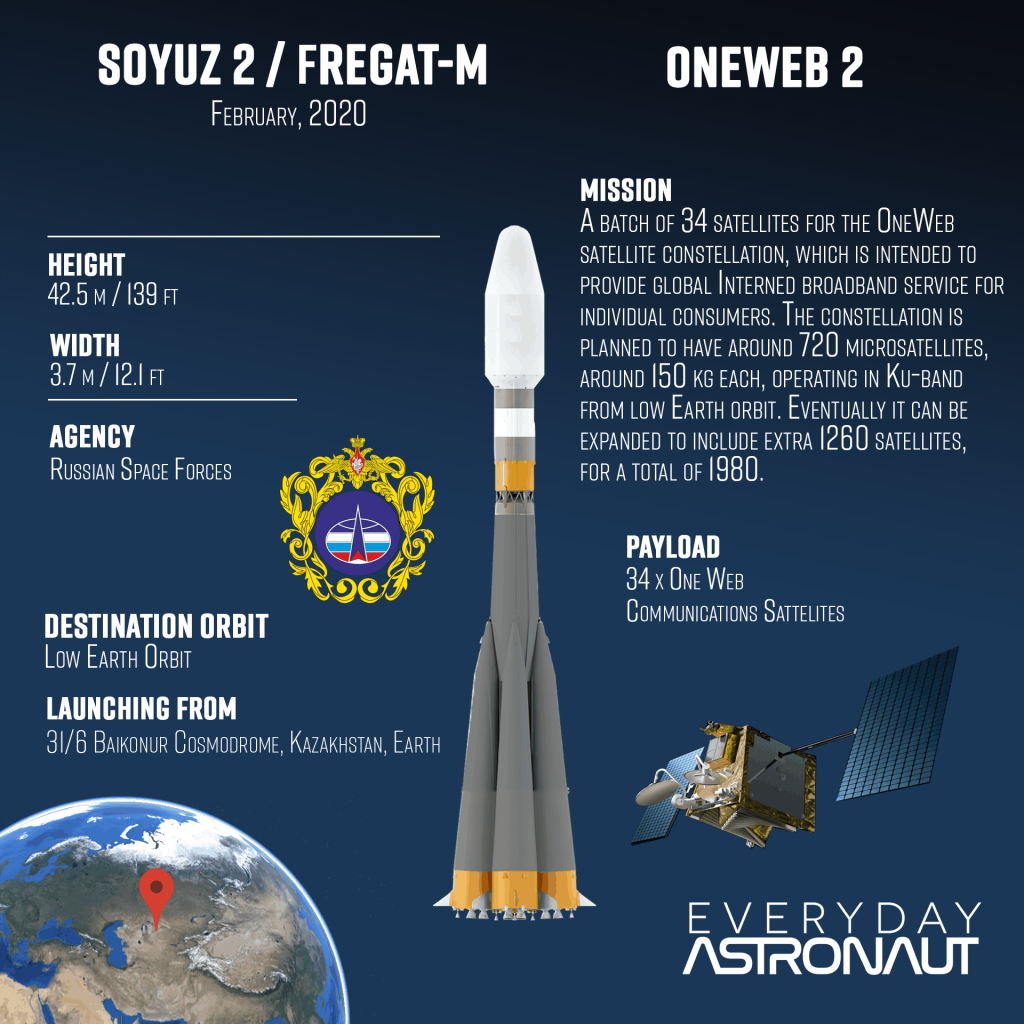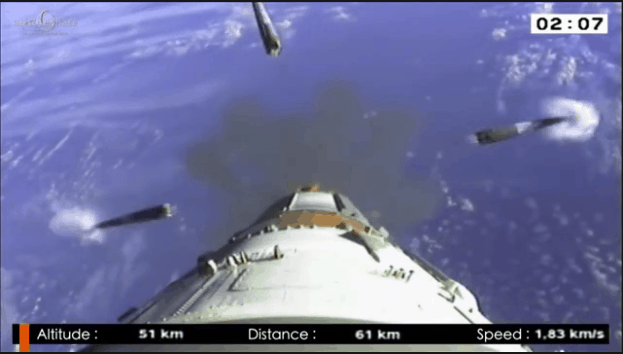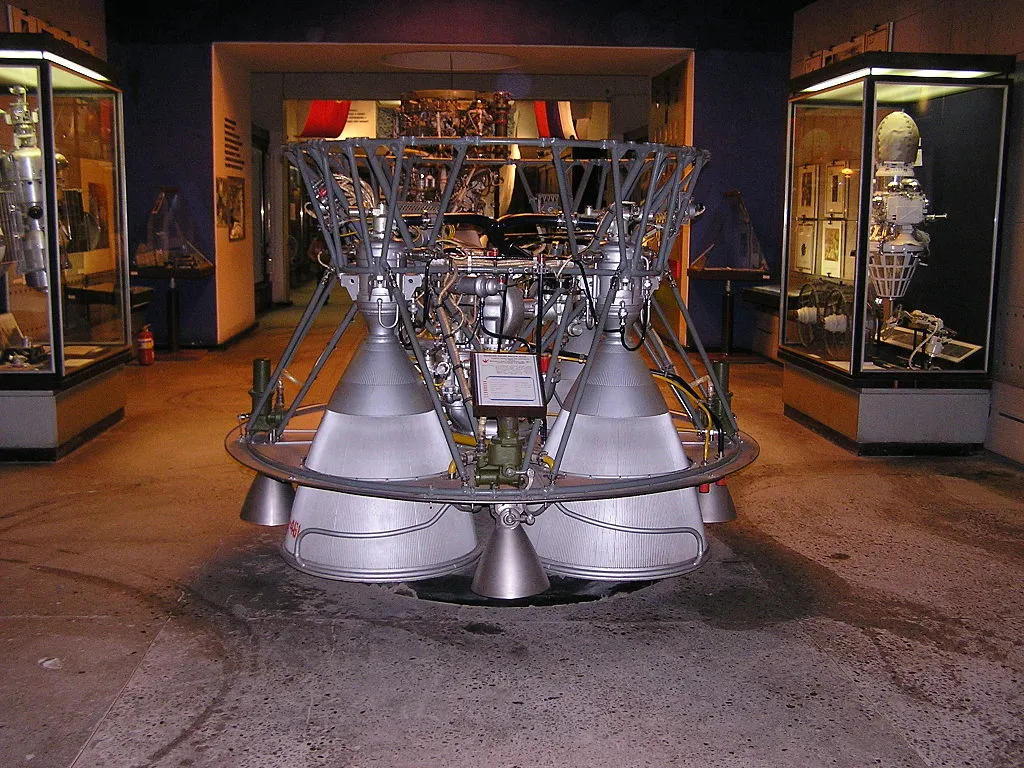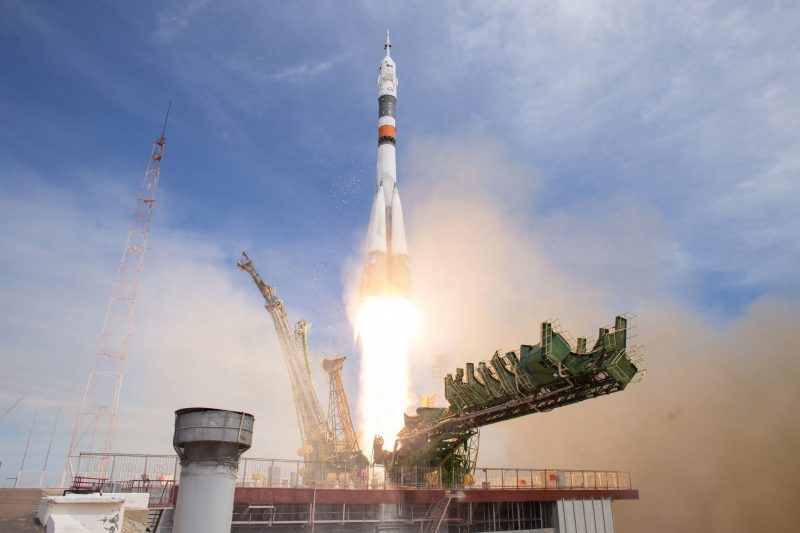Lift Off Time
|
February 6, 2020 – 21:42 UTC | 16:42 EST |
|---|---|
Mission Name and what it is |
OneWeb 2, 34 of OneWeb’s global communications satellites |
Launch Provider
|
Russian Federal Space Agency/Arianespace |
Customer
|
OneWeb |
Rocket |
Soyuz 2.1b |
Launch Location |
Baikonur Cosmodrome, Kazakhstan |
Payload mass |
~5,100 kg |
Where are the satellites going? |
Near polar orbit. Initial orbit of 450 km, final orbit of 1,200 km. |
Will they be attempting to recover the first stage? |
No. Soyuz rockets don’t have this capability. |
Where will the first stage land? |
It will crash into the ocean (near the North Pole) |
Will they be attempting to recover the fairings? |
No |
Are these fairings new? |
Yes |
This will be the: |
|
Where to watch |
Official Livestream |

What’s all this mean?
Introduced in 1966, Soyuz has been the workhorse of the Soviet/Russian space program. The first launch of the Soyuz 2-1a version on November 8, 2004 from the Plesetsk Cosmodrome represented a major step in the Soyuz launch vehicle’s development program. Fregat is the upper (4th) stage of Soyuz 2.1, and it first flew in the year 2000.
The Soyuz version currently being used for most satellite launches (as distinct from crewed capsules or cargo capsules to the ISS) is a four-stage launch vehicle, which consists of:
- four side boosters (first stage)
- a central core booster (second stage)
- a third (central) stage
- the re-startable Fregat “upper” stage (fourth stage)
The side boosters’ RD-107A engines are powered by liquid oxygen and kerosene, which are the same propellants used on each of the lower three stages. The kerosene tanks are located in the cylindrical part and the liquid oxygen tanks in the conical section. Each engine has four combustion chambers and four nozzles.
During side booster separation, the boosters perform a well-known pattern, in which they peel off and cartwheel outwards! This is known as the “Korolev cross”, named after Sergei Korolev, the Chief Design Engineer of the USSR space program in the 1960s.

The center core stage is fitted with an RD-108A engine, and also has four combustion chambers and four nozzles. It also has four vernier thrusters, used for three-axis flight control once the side boosters have separated. The third stage engine’s thrust enables the stage to separate directly from the central core. This is called “hot staging”.
The third stage uses either an RD-0110 engine in the Soyuz ST-A (2-1a) version or an RD-0124 engine in the ST-B (2-1b) version. This flight is using a 2-1b vehicle, so in this case, the stage has an RD-0124 engine.

Flight qualified in 2000, the Fregat upper stage is an autonomous and flexible stage that is designed to operate as an orbital vehicle. It extends the Soyuz launcher’s capability, now covering a full range of orbits (LEO, SSO, MEO, GTO, GEO and Earth escape). Fregat is independent of all the other stages, as it has its own guidance, navigation, attitude control, tracking, and telemetry systems. The stage’s engine uses storable propellants – UDMH (unsymmetrical dimethylhydrazine) and NTO (nitrogen tetroxide) – and can be restarted up to 20 times in flight so that it can carry out very complex missions.
The Fregat upper stage is encapsulated in a fairing with the payload and a payload adaptor/dispenser. So…
What about the payload?
OneWeb is launching 34 of its global communication satellites to a 1,200km polar orbit. OneWeb’s goal is to create a global network to bring internet service to everyone, anywhere. This is the first of many of OneWeb’s launches in 2020; their plan is to have 648 (19 launches) satellites in their constellation. This will provide them with 600 active satellites, with 48 on-orbit spares. The constellation is supposed to be ready for demos at the end of 2020, and able to provide full commercial global services in 2021.
This will mark the second launch of OneWeb’s communication satellites. On February 27th, 2019 they launched 6 test satellites on top of a Soyuz ST-B.





I’m thankfull to you for doing these news.
By the way, i Think that the customer for this mission is false. Isn’t the customer is Oneweb here ?
You’re right! Sorry that was my bad, thanks for correcting.